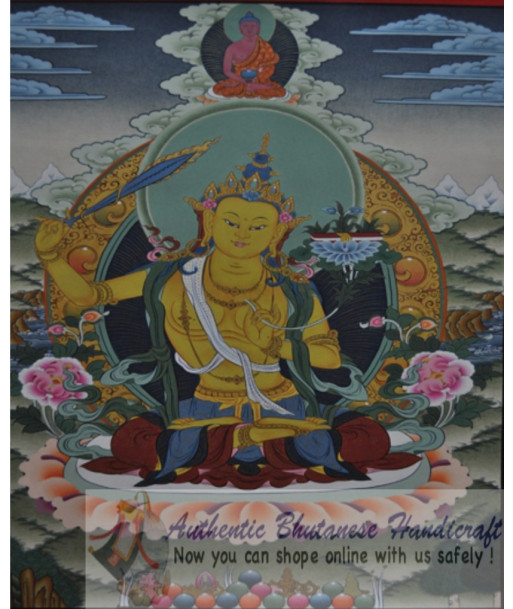- -50%







A **Jampelyang Thanka** painting features Jampelyang, also known as Manjushri (or Manjushri in Sanskrit), a revered bodhisattva in Mahayana Buddhism who embodies the wisdom of all Buddhas. Jampelyang is especially significant in Tibetan Buddhism as a symbol of enlightenment, wisdom, and the removal of ignorance.
 Security policy
Security policy
(edit with the Customer Reassurance module)
 Delivery policy
Delivery policy
(edit with the Customer Reassurance module)
 Return policy
Return policy
(edit with the Customer Reassurance module)
A **Jampelyang Thanka** painting features Jampelyang, also known as Manjushri (or Manjushri in Sanskrit), a revered bodhisattva in Mahayana Buddhism who embodies the wisdom of all Buddhas. Jampelyang is especially significant in Tibetan Buddhism as a symbol of enlightenment, wisdom, and the removal of ignorance.
### Key Elements of Jampelyang Thanka Painting:
1. **Central Figure**:
- **Manjushri (Jampelyang)**: The central figure is usually depicted as a youthful and radiant bodhisattva, embodying wisdom and clarity. Key features include:
- **Appearance**: Jampelyang is often shown with a golden or yellow complexion, symbolizing his association with wisdom and the illumination of the mind.
- **Posture**: He is typically seated in a meditative posture, often on a lotus throne or cushion. His posture conveys calm and contemplation.
2. **Attributes**:
- **Sword of Wisdom**: One of the most iconic attributes of Manjushri is the sword he wields. The sword represents the cutting of ignorance and delusion, and it is often depicted held high, symbolizing the power of wisdom to cut through the veils of ignorance.
- **Wisdom Sutra**: In his other hand, he often holds a wisdom text or sutra, usually the "Prajnaparamita Sutra," symbolizing his deep knowledge and understanding of the nature of reality.
3. **Iconography**:
- **Lotus Flower**: Jampelyang is usually seated on a lotus flower or cushion, which represents purity and the blossoming of wisdom.
- **Radiant Aura**: A halo or radiant light often surrounds him, symbolizing his enlightened state and the illumination he brings to practitioners.
4. **Background and Surroundings**:
- **Sacred Landscapes**: The background may include serene and auspicious landscapes such as heavenly realms, lush gardens, or mountain scenes, reflecting the sacred nature of his presence.
- **Symbolic Details**: The painting might incorporate additional symbols such as the Eight Auspicious Signs (Ashtamangala), which enhance the spiritual significance of the depiction.
5. **Mantras and Texts**:
- **Inscriptions**: Tibetan script or mantras related to Manjushri's wisdom and teachings may be included around or within the painting. These texts are often used to invoke his blessings and wisdom during meditation and rituals.
### Significance:
- **Embodiment of Wisdom**: Manjushri (Jampelyang) is revered as the embodiment of supreme wisdom in Mahayana Buddhism. The thanka serves as a visual representation of his qualities and teachings, helping practitioners focus on the development of wisdom and understanding.
- **Spiritual Practice**: The Jampelyang Thanka is used in meditation and devotional practices to connect with Manjushri's wisdom. Practitioners seek his blessings to overcome ignorance and gain insight into the nature of reality.
- **Teaching Tool**: The painting acts as a teaching aid, illustrating the principles of wisdom and the path to enlightenment. It helps practitioners visualize and internalize the qualities associated with Manjushri.
The Jampelyang Thanka is a powerful spiritual tool, both as a devotional object and as a guide for meditation, reflecting the deep reverence for Manjushri's wisdom and the transformative potential of enlightened insight in Tibetan Buddhism.